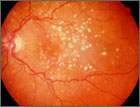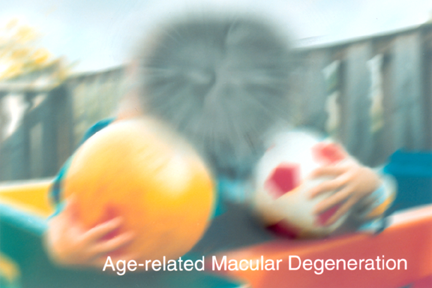Macular Degeneration
What is it?

Age-related macular degeneration (AMD) is the leading cause of blindness in Americans over the age of 60. It is estimated that 10 million people suffer from AMD. The prevalence of AMD increases with increasing age.
AMD is caused by a breakdown of the macula of the eye. The macula functions as a small area in the retina in the back of the eye that allows us to see fine details clearly. The retina functions as the “film” of a camera, processing images for the eye, and the macula is the “bull’s eye” of the retina.
AMD is broken down into “dry” and “wet” AMD. Most people have “dry” AMD, and visual loss is usually very gradual. “Wet” AMD is less common and usually occurs in about 10% of the people who have AMD. People who have “wet” AMD may experience rapid and severe vision loss.
Signs and Symptoms
Because the macula is in the center of the retina, someone with macular degeneration will have the center of their eyesight compromised and therefore will see a blurred or dark spot. People who have AMD do not lose their peripheral sight.
AMD rarely causes complete blindness. In many cases, the progression of AMD may be slight and steady. It may be even more difficult to recognize slight changes if it occurs in only one eye. Our doctors can help detect the early stages of AMD during your routine eye examination. It is extremely important to communicate any changes in your vision, regardless of how seemingly slight or insignificant you may consider them to be.
If you experience any of the following symptoms, please contact the South County Eye Care eye doctors to schedule an appointment:
- • Loss of central vision. A dark, empty or blurred spot appears in the center of your vision.
- • Distorted vision. Straight lines such as doorways or window frames appear wavy or bent.
- • Difficulty reading or performing tasks that require the ability to see detail.


Prevention
There is no cure for macular degeneration. However, simple lifestyle changes may help slow the progression of AMD:
- • Eat green leafy vegetables (kale, spinach, collard greens)
- • Protect your eyes with sunglasses with UV protection; wear a hat
- • Quit smoking
- • Exercise (improves circulation to the eyes)
- • Use an Amsler grid on a regular basis to help monitor changes to your vision
- • Vitamin therapy. The AREDS 2 study (AGE-related Eye Disease Study) found that taking a specific formulation reduced the progression of intermediate AMD. Consult with Dr. Tekwani before beginning any therapy. The recommended AREDS 2 formulation is:
- • Vitamin C: 500mg
- • Vitamin E: 400 IU
- • Zinc: 80mg
- • Copper: 2mg
- • Lutein: 10mg
- • Zeaxanthin: 2 mg
Treatment
There is currently no cure for macular degeneration. For some forms of “wet” macular degeneration, different forms of laser surgery may be an option.
Low vision resources and aids can assist people to lead more independent lives with their remaining sight. St. Louis Society for the Blind and Visually Impaired offers social work assessment and referral, independent living skills, leisure and recreation opportunities, assistive technology and emotional support. For more information, visit their website at http://www.slsbvi.org.
